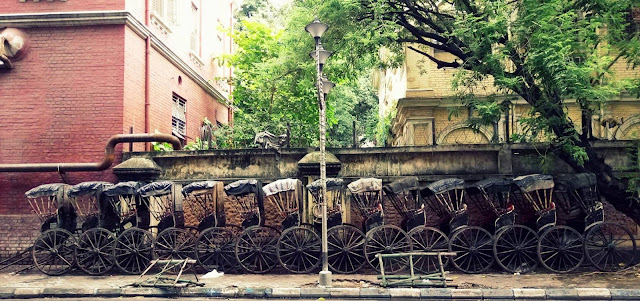College Street: The Disillusionment.. | Sourangsu Bandyapadhyay

As a Calcuttan I witness with deep sadness the decline of a great city. Calcutta these days looks like a rich Zamindar (landed gentry) falling into hard times. Yet in this city there exists an institution which I consider to be one of the best in the academically inclined world. I am talking of College Street ‘boi para’ (The ‘book shops/stores’ of College Street). Noted Bengali writer Shankar once lamented on closure of Thacker Spink, a Barnes and Nobles of India. Adults are biased towards stories that have a beginning, middle and an end. In that order, Children don’t really care; they just want to know “what happens next”. From this perspective, there should be more children on College Street. Although the maps will tell you College Street runs from Bowbazar to Mahatma Gandhi Road (Harrison Road as was), this is a part of Calcutta that has no discernible beginning nor an end. Every time you think you’ve reached one end of it, three more book-stalls appear under yet another tarpaulin-rigged awning. Side lanes, porticos, lobbies of peeling old houses, in this part of town they breed books like buildings elsewhere grow mold. On a late Saturday morning when the colleges give over early and the book-loving Bengali babu is starting his weekend, this para buzzes with activity like an ant’s nest that’s just sighted an aardvark. College Street, as we sincerely believe, is the biggest hub of publishing and bookselling activities in the eastern part of the country. Earlier, Chitpur and Garanhata was the sanctum sanctorum of vernacular publishing. The place was popularly known as Battala. The rich oral tradition of the folktales of Bengal, typically juxtaposed with traditional yellow-cover-pornography and religious texts, used to be a major attraction for readers in those days. Later, the market was shifted to College Street in keeping with the literary and reformist spirit prevailing in and around Hindu College. The tidal wave of Bengal Renaissance caused some significant reforms in publishing, and bookselling activities as well, under the astute leadership of William Carey and Pundit Ishwar Chandra Vidyasagar. In course of time, such futuristic ideas of book business culminated into what we call today ‘Boi para’ (the book district) of Bengal. Boi para of College Street is not only the centre for bookmaking and bookselling; it is synonymous with intellectual literary crosscurrents of contemporary thinkers. Boi para is a place where one can find the Coffee House, ceaselessly vibrating with political arguments, while in the wayside stalls, the incorruptible book lovers are always on the lookout for some hidden treasure in the pile of books. It is a confluence of old books and new ideas. Calcutta University, Sanskrit College, Hindu School and a few other academic institutions impart unparalleled intellectual distinction to the place. Our story had its beginning in a conversation a week before our visit. A school of mine had dismissed the College Street boi para (roughly, “neighbourhood of books”) as a flea-market for crammers’ texts and second-hand potboilers. “Can you find anything in any language that is RARE, let alone interesting?” Out of nowhere, we fixed on Dwijendranath Tagore’s Gitapatha (The Translation of the Gita), as the touchstone. Could we find anything by him on College Street? So it came to pass that 11 o’clock on a cloudy humid Saturday saw us stepping gingerly through puddles, wiping our faces repeatedly under the combined onslaught of humidity and a faint drizzle, glancing with unconcealed disgust at stall after stall that advertised “CBSE-ICSE-ISC text” or “Medical – JEE – CAT”. Was this what College Street had been reduced to? Where were the bonanzas that our parents’ generation gloated over, the pamphlet autographed by Toru Dutt or the 1898 edition of the Materia Medica? The Coffee House lane (Bankim Chatterjee Street) is entirely devoted to textbooks. (What a waste - even during our student days some decades ago, textbooks never figured on our list of priorities.) Yet it makes historical sense. Hindu College in 1817, Sanskrit College, the Calcutta Medical College in 1835, Calcutta University and later Presidency College (now Presidency University) – these were all started on College Street or just off it in the Potoldanga area. Small wonder was that the College Street boi para took root, almost 200 years ago, from the textbook trade. For more esoteric books and for the latest rage, the gentry ordered in from the booksellers in the Chowringhee area. It was only at the turn of the (previous) century that College Street’s booksellers increased the ambit of their trade. And the stories of lost treasures glimpsed in dusty piles on the pavement took root, grew, gave rise to myths and tall tales. These tales were most often told in the Coffee House, the adopted home of generations of self-proclaimed Bengali intelligentsia. Housed in the Albert Hall (yes, of course there had to be one in the “second city of the Raj”! This one was built in 1876), this was the place to enjoy the best adda, the slowest service and the most tolerant waiters in the world. Poets, economists, politicians, charlatans, they all spent hours and days over carefully nursed cups of coffee and shared cigarettes under the slow revolving fans strung on beams between the upper floor balconies. Every Bengali of note, from Rabindranath Tagore to Amartya Sen, has been a patron. One of the most enduringly popular Bangla songs is Manna Dey’s anthem to nostalgia, "Coffee House-er shei adda." Yet like most things Bengalis hold dear, it has been on the brink of oblivion for years. It took a petition from the faculty of Calcutta University and the Presidency College to keep it from being shut down in 1958. Eventually, in 1995, Mudar Patherya led an initiative for essential renovation and again in 2007, Bengal Shelter cleaned and renovated it. Today it is almost chic in its ambience. Of course there are old-timers who miss the smoke-blackened walls and the chipped Coffee Board saucers. But they still serve the most soul-satisfying greasy “Mutton Afghani”. I can vouch for this because, of course, we ended our College Street expedition there. But again the time-line jinks. The book search, yes! We pushed through the crowds on the sidewalk in our search for old books, yet all we found within that tunnel of blue polythene rain-sheets was text-books, children’s books and self-help books. We crossed to the other side of the road and found a different world. Piles upon piles of pulp fiction, literary criticism, photography, and yearbooks. Obviously this side, along the wall of Presidency University, is more fun. Subol Moitra from Medinipur peeped shyly from his book-walled alcove and edified us about the complicated system of rental and sub-rental that governed the economy of these six by four “locations”. But where oh where, among this rubble of Harold Robbins and Fashion Photography, were we to find anything by the great Dwijendranath Tagore? Back to the other side we went, picking our way between reddish-chocolate mini-buses, bright yellow taxis and rickshaws with schoolchildren peeking out from behind the inevitable blue polythene sheet We had a set of questions and plenty of curiosity in our minds. The most distinguished bookseller in this part of the world is Dasgupta & Company with a rich heritage of a little more than 150 years. Deys Publishing, Ananda Publishers, M. C. Sircar—these three are, unmistakably, icons of Bengali publishing in Bengal. They have backlist of bestsellers at their disposal. Sarat Book House is a meticulously managed literary supplier with specialization in Mathematics and Physics as their area of publishing. At Indiana Bookstore we found a neat pretty bookshop with the latest arrivals from the International market. Chuckerverthy Chatterjee is as spacious as any huge departmental store with well-managed stocks of books on various topics in various languages. Rupa, of course, deserves special mention for its formidable publishing programme in English. Anushtup and Saptarshi are quality-sensitive publishers with sharp eyes on the intellectual heritage of Bengal. Pratikshan has hawk-eyed editorial and production staff to look after the well-produced art books. Punascha, like Dey’s Publishing, has its own binding infrastucture besides the collossal publishing programme aiming at a huge cross-section of readership. Shishu Sahitya Samsad is a name to reckon with in the field of children’s and young adult literature in Bengali and English. Sahitya Samsad is the publisher of the finest dictionaries in the country. But where oh where can we find the book that we sought out for!!!! After searching for about 3-4 hours in and around college street we finally had to give up on our quest...essentially My Quest!!! We boarded the bus (Route No. 219) and made our journey homewards with drooping faces and words lingering in my mind....... "Narayan Gongopadhyay, in his Desh column "Sunondor Journal" once admitted that his idea of heaven-on-earth was bringing the golden days of yore back to College Street for just one day, when textbooks, 'notebooks' and suggestions would disappear, and brand new inexpensive books of poetry, plays, essays and novels from all over India and beyond would take their place." |

 কলকাতা
কলকাতা 

Comments
Post a Comment